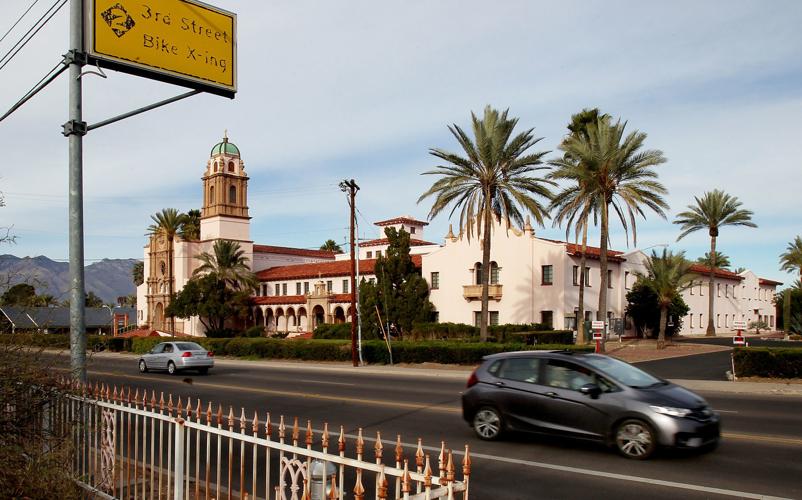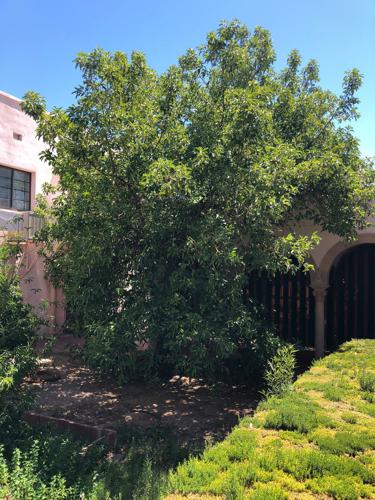The developer of the Benedictine Monastery site has agreed to lower the height of the tallest proposed apartment buildings by 19 feet, protect the structure as a historic landmark and preserve a beloved avocado tree on the grounds.
But the gesture may not be enough for some who want the entire site — orchards, walking paths and quiet spaces — spared from development after the Tucson City Council’s intervention last month to begin the process of historic designation for the monastery.
The 6-acre site, at 800 N. Country Club Road, was bought by local developer Ross Rulney last year after the Benedictine Sisters of Perpetual Adoration sold it to relocate to Missouri.
In a letter to the mayor and council, delivered Friday, architect Corky Poster said the new proposal would provide 222 units — the number currently allowed — prohibit student housing and protect the monastery from demolition.
Rulney needs the city to rezone the site from its current allowable use of group dwelling, which includes student housing, and office space to multifamily housing and retail.
“It will cost the city nothing and produce property and sales tax,” Poster wrote. “Or the Mayor and Council can reject the new proposal, leaving Ross to build under current zoning, likely student housing.”
In that scenario, the architectural firm Poster Frost Mirto would bow out of the project because it specializes in historic preservation, not student housing.
“Let’s stop the expensive gamesmanship and work together … to develop a project that we all can enjoy and be proud of,” Poster wrote.
DESIGN DISPUTE
The original plan featured two buildings north and south of the monastery with a height of 85 feet and a third building on the east with a height of 55 feet. The revised plan proposes two 66-foot-buildings north and south and a 45-foot building on the east.
A sticking point for the city councilman who represents the area neighborhoods is that the buildings not be taller than the monastery.
Rulney and Poster say the building will be 22 and 33 feet lower than the monastery height, but Councilman Steve Kozachik said the measure of “height” should not include the cupola.
“We just fundamentally disagree with the idea of what they’re proposing,” Kozachik said. “I told Corky he should not count on me leading a parade down Country Club with pompoms in support of it.”
Shorter buildings would be “a conversation starter” Kozachik said, but declined to say what height he would accept.
“I’m not designing the building for them,” he said. “Design guidelines are no taller than the existing building — the building mass.”
Kozachik, who initiated proceeding with historic designation of the monastery, said the designation would apply to the whole site.
“There’s room to use the site as a negotiating piece,” he said. “He may not be able to develop what he wants to develop, but he can develop something.”
Beyond immediate neighbors, Kozachik said he has gotten feedback from people all over the city to protect the monastery.
“The ball is in their court and we’re moving forward with the historic listing process,” he said. “While that’s going on, they’re perfectly free to come in and talk about what can be built.”
A group of residents from the Miramonte and Sam Hughes neighborhoods did not embrace the latest proposal.
The “vote by the mayor and council was a game changer in reorienting this discussion toward solutions that respect the historic building and the neighborhoods,” Neighbors for Reasonable Monastery Development said in a statement sent to the Star.
“We urge the development team to recognize this new environment and explore real alternatives beyond the six- or seven-story apartment towers we have seen thus far.”
RETURN ON INVESTMENT
Rulney and Poster say they believe there is broad support for market-rate rentals on the property.
“It provides a currently nonexistent housing choice for middle-income millennials and empty-nesters that want to live near all the amenities Sam Hughes and Miramonte residents enjoy,” Poster said.
Rulney said the concession of two stories was a nod to the feedback from neighbors, as was his promise to preserve the large avocado tree in the courtyard. He said he has no intention of selling the site.
“I will develop the property, preserve the monastery and protect my rights of ownership,” he said.
More units — and subsequent height — are the only way to get a return on investment, Poster said. The current height limit is 40 feet.
“In order to keep per-square-foot costs of quality construction at a level that can be repaid by the top end of that rental market, we need the economies of scale, i.e. more units,” he said. “Without that, only higher rents will solve our problem. And those higher rents are only available from student housing.”
If the rezoning isn’t approved, Rulney will proceed with development of student housing, as is currently allowed.
“The sisters marketed and sold the property based on highest and best use, and student housing is just that,” he said. If that’s the case, the only rezoning needed would be for the monastery to be developed for retail, hospitality, boutique or wellness.
“Today’s zoning allows student group dwelling and office,” Rulney said, “which dictates that the existing building will only be visited by those who lease space and without public access.”
“There’s room to use the site as a negotiating piece. He may not be able to develop what he wants to develop, but he can develop something.” Steve Kozachik, Tucson city councilman






